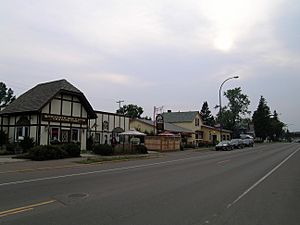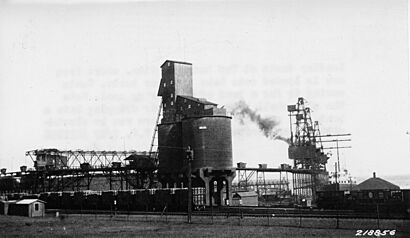Two Harbors, Minnesota facts for kids
Quick facts for kids
Two Harbors
|
|
|---|---|
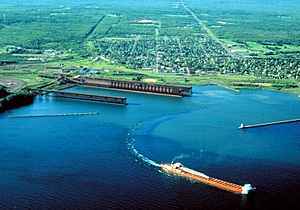
Aerial view of Two Harbors. Exact photo date unknown, but appears to be from the mid-late 1990s.
|
|
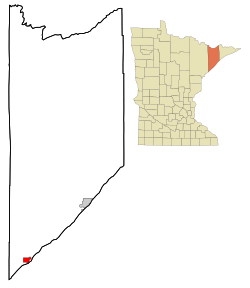
Location of the city of Two Harbors
within Lake County, Minnesota |
|
| Country | United States |
| State | Minnesota |
| County | Lake |
| Platted | 1885 |
| Incorporated (village) | 1888 |
| Incorporated (city) | February 26, 1907 |
| Area | |
| • Total | 3.28 sq mi (8.50 km2) |
| • Land | 3.27 sq mi (8.48 km2) |
| • Water | 0.01 sq mi (0.02 km2) |
| Elevation | 673 ft (205 m) |
| Population
(2020)
|
|
| • Total | 3,633 |
| • Estimate
(2022)
|
3,585 |
| • Density | 1,109.99/sq mi (428.58/km2) |
| Time zone | UTC-6 (Central (CST)) |
| • Summer (DST) | UTC-5 (CDT) |
| ZIP code |
55616
|
| Area code(s) | 218 |
| FIPS code | 27-65956 |
| GNIS feature ID | 0658799 |
Two Harbors is a city in Lake County, Minnesota, United States. It is the main city of the county. The city is located along the shore of Lake Superior. In 2020, about 3,633 people lived there. Minnesota State Highway 61 is the main road in Two Harbors. Gooseberry Falls State Park is about 13 miles (21 km) northeast. The city has a port where iron ore is shipped out.
Contents
History of Two Harbors
In its early days, Two Harbors was made of two towns: Agate Bay and Burlington. The village of Burlington started in 1856. Agate Bay began in 1883 when workers came to build a new railroad. The village of Two Harbors was officially planned in 1885. It became a village in 1888.
Early settlers lived in simple homes made of logs. They often ate vegetables they grew and animals they caught. Travel to the village was by boat or horse. It took a whole day to get from Duluth to Two Harbors. By 1886, a railroad connected Duluth and Two Harbors. On February 26, 1907, the village became the City of Two Harbors.
You can learn more about the town's history at the Lake County Historical Depot Museum.
Whiskey Row: A Busy Spot in Early Two Harbors
In 1883, a company bought most of the land around Agate Bay. A man named Thomas Sexton owned four acres. He rented this land to businesses that wanted to serve the 600 workers building the railroad. This area became known as "Whiskey Row." It was a very busy place.
Some people thought a fire destroyed Whiskey Row in 1888, but that's not quite right. A smaller fire happened in 1884, but the businesses quickly rebuilt. Whiskey Row actually closed in 1885. The railroad needed the land for its growing operations. The buildings were moved further inland. Some homes in Two Harbors today were once part of Whiskey Row.
Railroad and Iron Ore Transport
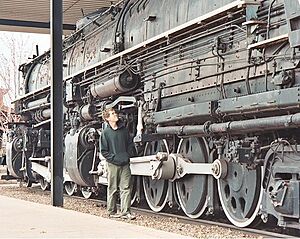
Two Harbors exists because iron ore was found nearby. The Minnesota Iron Company bought a lot of land to build a railroad. Agate Bay was chosen for the port because it was close to the ore and had a good bay.
Building the railroad was hard. Heavy items like train engines had to be moved by boat, which was risky. The first iron ore cars left Agate Bay on July 31, 1884. The railway between Duluth and Two Harbors was finished in 1886.
Today, the North Shore Scenic Railroad offers train rides from Duluth to Two Harbors. You can see two old steam locomotives on display in Two Harbors. One is a 2-6-0 Mogul class engine. The other is a 2-8-8-4 Yellowstone class engine, which is one of the largest ever built.
City Government Changes
In 2022, the city's mayor, Chris Swanson, was removed from office by a special vote. This happened after several disagreements. The City Council President, Ben Redden, took over the mayor's duties. A new election will be held to choose the next mayor.
Geography and Climate of Two Harbors
Two Harbors is about 20 miles (32 km) northeast of Duluth, Minnesota. It sits on the shore of Lake Superior. The city gets its name from two natural harbors: Burlington Bay and Agate Bay.
The warmest month in Two Harbors is July. The coldest month is January. The highest temperature ever recorded was 99°F (37°C) in 1948. The lowest was -36°F (-38°C) in 1996.
Two Harbors is in a forest area with many types of trees. The region gets about 21 to 32 inches (53 to 81 cm) of rain each year. The average temperature is 34 to 40°F (1 to 4°C).
| Climate data for Two Harbors, Minnesota (1991–2020 normals, extremes 1894–present) | |||||||||||||
|---|---|---|---|---|---|---|---|---|---|---|---|---|---|
| Month | Jan | Feb | Mar | Apr | May | Jun | Jul | Aug | Sep | Oct | Nov | Dec | Year |
| Record high °F (°C) | 57 (14) |
59 (15) |
75 (24) |
88 (31) |
94 (34) |
98 (37) |
99 (37) |
99 (37) |
92 (33) |
86 (30) |
70 (21) |
62 (17) |
99 (37) |
| Mean daily maximum °F (°C) | 23.7 (−4.6) |
27.8 (−2.3) |
36.9 (2.7) |
47.6 (8.7) |
58.1 (14.5) |
67.0 (19.4) |
75.1 (23.9) |
74.5 (23.6) |
66.8 (19.3) |
53.9 (12.2) |
40.0 (4.4) |
28.5 (−1.9) |
50.0 (10.0) |
| Daily mean °F (°C) | 15.6 (−9.1) |
19.0 (−7.2) |
28.7 (−1.8) |
39.1 (3.9) |
48.4 (9.1) |
56.3 (13.5) |
64.8 (18.2) |
65.3 (18.5) |
57.8 (14.3) |
45.9 (7.7) |
33.0 (0.6) |
21.4 (−5.9) |
41.3 (5.2) |
| Mean daily minimum °F (°C) | 7.4 (−13.7) |
10.1 (−12.2) |
20.5 (−6.4) |
30.7 (−0.7) |
38.6 (3.7) |
45.7 (7.6) |
54.5 (12.5) |
56.0 (13.3) |
48.8 (9.3) |
37.9 (3.3) |
26.1 (−3.3) |
14.2 (−9.9) |
32.5 (0.3) |
| Record low °F (°C) | −36 (−38) |
−36 (−38) |
−28 (−33) |
−15 (−26) |
9 (−13) |
29 (−2) |
37 (3) |
37 (3) |
23 (−5) |
0 (−18) |
−18 (−28) |
−33 (−36) |
−36 (−38) |
| Average precipitation inches (mm) | 1.04 (26) |
1.16 (29) |
1.51 (38) |
2.65 (67) |
3.30 (84) |
4.23 (107) |
4.05 (103) |
3.48 (88) |
3.53 (90) |
3.03 (77) |
2.18 (55) |
1.56 (40) |
31.72 (806) |
| Average snowfall inches (cm) | 12.4 (31) |
13.6 (35) |
9.1 (23) |
4.3 (11) |
0.0 (0.0) |
0.0 (0.0) |
0.0 (0.0) |
0.0 (0.0) |
0.0 (0.0) |
0.2 (0.51) |
5.9 (15) |
15.5 (39) |
61.0 (155) |
| Average precipitation days (≥ 0.01 in) | 10.1 | 8.5 | 8.6 | 9.9 | 12.6 | 13.4 | 11.8 | 10.5 | 11.7 | 11.5 | 9.1 | 9.8 | 127.5 |
| Average snowy days (≥ 0.1 in) | 8.2 | 6.5 | 4.2 | 1.7 | 0.0 | 0.0 | 0.0 | 0.0 | 0.0 | 0.1 | 2.6 | 7.2 | 30.5 |
| Source: NOAA | |||||||||||||
| Climate data for Two Harbors 7NW, Minnesota, 1991–2020 normals: 1355ft (413m) | |||||||||||||
|---|---|---|---|---|---|---|---|---|---|---|---|---|---|
| Month | Jan | Feb | Mar | Apr | May | Jun | Jul | Aug | Sep | Oct | Nov | Dec | Year |
| Mean daily maximum °F (°C) | 19.6 (−6.9) |
25.3 (−3.7) |
36.9 (2.7) |
49.6 (9.8) |
63.7 (17.6) |
72.3 (22.4) |
77.3 (25.2) |
74.8 (23.8) |
65.8 (18.8) |
51.4 (10.8) |
36.1 (2.3) |
24.0 (−4.4) |
49.7 (9.9) |
| Daily mean °F (°C) | 10.3 (−12.1) |
14.2 (−9.9) |
26.0 (−3.3) |
38.5 (3.6) |
51.0 (10.6) |
60.2 (15.7) |
65.4 (18.6) |
63.7 (17.6) |
55.2 (12.9) |
42.7 (5.9) |
28.7 (−1.8) |
16.1 (−8.8) |
39.3 (4.1) |
| Mean daily minimum °F (°C) | 1.1 (−17.2) |
3.2 (−16.0) |
15.0 (−9.4) |
27.3 (−2.6) |
38.3 (3.5) |
48.1 (8.9) |
53.5 (11.9) |
52.6 (11.4) |
44.6 (7.0) |
34.1 (1.2) |
21.2 (−6.0) |
8.2 (−13.2) |
28.9 (−1.7) |
| Average precipitation inches (mm) | 1.25 (32) |
1.26 (32) |
1.69 (43) |
2.90 (74) |
3.45 (88) |
4.52 (115) |
3.67 (93) |
3.65 (93) |
3.68 (93) |
3.27 (83) |
2.30 (58) |
1.97 (50) |
33.61 (854) |
| Average snowfall inches (cm) | 18.60 (47.2) |
17.80 (45.2) |
12.30 (31.2) |
9.00 (22.9) |
0.90 (2.3) |
0.00 (0.00) |
0.00 (0.00) |
0.00 (0.00) |
0.00 (0.00) |
2.80 (7.1) |
10.60 (26.9) |
21.60 (54.9) |
93.6 (237.7) |
| Source: NOAA | |||||||||||||
Population and People of Two Harbors
| Historical population | |||
|---|---|---|---|
| Census | Pop. | %± | |
| 1890 | 1,224 | — | |
| 1900 | 3,278 | 167.8% | |
| 1910 | 4,990 | 52.2% | |
| 1920 | 4,546 | −8.9% | |
| 1930 | 4,425 | −2.7% | |
| 1940 | 4,046 | −8.6% | |
| 1950 | 4,400 | 8.7% | |
| 1960 | 4,695 | 6.7% | |
| 1970 | 4,437 | −5.5% | |
| 1980 | 4,039 | −9.0% | |
| 1990 | 3,651 | −9.6% | |
| 2000 | 3,613 | −1.0% | |
| 2010 | 3,745 | 3.7% | |
| 2020 | 3,633 | −3.0% | |
| 2022 (est.) | 3,585 | −4.3% | |
| U.S. Decennial Census 2020 Census |
|||
In 2010, there were 3,745 people living in Two Harbors. Most residents (97.2%) were White. About 22% of the people were under 18 years old. The average age in the city was 41.3 years. There were slightly more females (52.6%) than males (47.4%).
Industries in Two Harbors
Two Harbors is home to Granite Gear, a company that started in 1986. They make strong backpacks for outdoor activities and the military.
Past Industries in Two Harbors
Two Harbors once had several other industries.
Cigar Factories
In the early 1900s, Two Harbors had two cigar factories. John H. Kallin built one in 1900. Ed Sorenson built another in 1907. These factories are no longer in business.
Universal Fiberglass
From 1964, the Universal Fiberglass company used old railroad buildings. They made three-wheeled mail trucks for the United States Postal Service. They also made car parts. A fire damaged the factory, and it had to close.
Bottling Works
Two Harbors Bottling Works started in 1912. They made different kinds of soda pop, like cream soda and ginger ale. They were known for their special strawberry pop. This company is also no longer running.
3M Company History
The famous company 3M, originally called Minnesota Mining and Manufacturing Company, was started by five men from Two Harbors. They thought they had found a mineral for sandpaper. They built a dock and crushing mill. Later, they learned the mineral was not what they thought. The company moved to Duluth in 1905 and then to St. Paul in 1907.
Today, the only link 3M has to Two Harbors is a museum. It is in the original office building of one of the founders, John Dwan. The building is a historic place. The museum shows Dwan's office and tells the story of 3M's beginnings.
Arts and Culture in Two Harbors
Two Harbors has a rich cultural history.
Edna G. Tugboat Tours
The Edna G. is a famous tugboat built in 1896. It was named after the railroad president's daughter. The Edna G. worked in Two Harbors for most of its life. It was the last coal-powered, steam tugboat on the Great Lakes when it retired in 1981. You can take tours of the Edna G. from spring to fall. You can even visit the engine room and blow the horn! The boat is listed as a historic place.
John Beargrease Dog Sled Race
Mok-qua Bennete, also known as John Beargrease, was an Ojibwe man. He delivered mail between Two Harbors and Grand Marais. The John Beargrease Dog Sled Race honors him. It is a long dog sled race, nearly 400 miles (640 km) long. The race happens every year in late January.
Other Local Events and Culture
Two Harbors hosts several fun events. These include the Lake County Fair and Heritage Days. It is also a checkpoint for the Beargrease Sled Dog Marathon. The city is the starting point for Grandma's Marathon and the NorthShore Inline Marathon.
A writer named Dean L. Hovey wrote mystery books set in a fictional Two Harbors senior living center. The books are Whistling Pines, Whistling Sousa, and Whistling Wings.
Two Harbors Public Library
The Two Harbors Public Library opened in 1909. It was built with a grant from Andrew Carnegie. Before that, books were kept in different city offices. In 1983, the library added more space. It now has over 30,000 books, magazines, CDs, audiobooks, and DVDs. The Archives Room has old photos and local newspapers from the late 1890s.
Parks and Recreation in Two Harbors
Two Harbors has five community parks. They have picnic tables, sports fields for baseball, soccer, and football, and playgrounds. Thomas Owens Park has a bandshell where the Two Harbors City Band plays. This is Minnesota's oldest city band.
Two Harbors is known as the "gateway city" to the North Shore of Minnesota. Highway 61 is the main road that goes along Lake Superior's shore. It leads to eight state parks:
- Gooseberry Falls
- Split Rock Lighthouse
- Tettegouche
- George H. Crosby Manitou State Park
- Temperance River State Park
- Cascade River State Park
- Judge C.R. Magney State Park
- Grand Portage State Park
The Two Harbors area also hosts outdoor events like the Heck of the North gravel bike race.
Trails for Outdoor Adventures
Two Harbors offers access to many trails. The Sonju hiking trail lets you see the shoreline. For snowmobiling, there are the North Shore State Snowmobile Trail, Yukon Snowmobile Trail, and Brimson Snowmobile Trail. There is also the Erkki Harju Ski Trail for cross-country skiing.
Education in Two Harbors
In 1901, Two Harbors decided to build a high school. Two Harbors Central High School opened in 1902. It had 50 students and three teachers. Early classes included arithmetic, grammar, and American history. Later, Latin, music, science, and sewing were added.
By 1909, the school had 98 students and seven teachers. In 1939, a new high school building was completed. In 2003, people voted to build an even newer high school. This new building opened in 2005. Students now use hiking trails, ponds, and a football field at the school. The old high school building was taken down in 2008.
Notable People from Two Harbors
Many interesting people have connections to Two Harbors:
- Philip Berrigan – a famous activist, was born here.
- Rhonda Britten – an actress and author, was born here.
- Leroy Goldsworthy – an NHL hockey player, was the first Minnesotan to win the Stanley Cup.
- Jeremy Mayer – a sculptor, went to middle and high school here.
- Don Moen – a singer and songwriter, graduated from Two Harbors High School.
- Lute Olson – a Hall of Fame college basketball coach, coached the Two Harbors High School team from 1957 to 1961.
- Johnny Western – a singer, musician, and actor, was born here.
Images for kids
See also
 In Spanish: Two Harbors (Minnesota) para niños
In Spanish: Two Harbors (Minnesota) para niños



